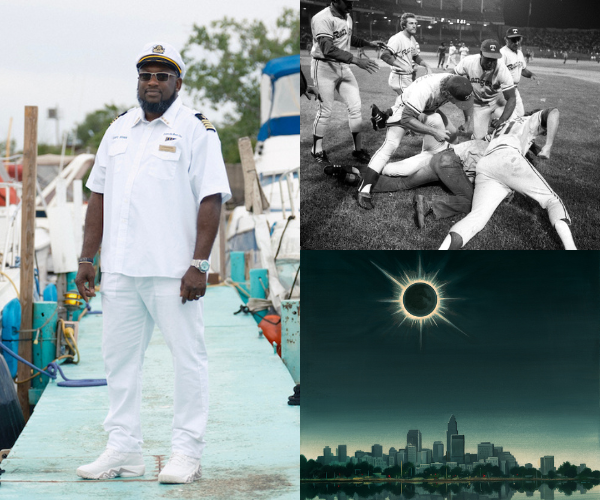On Reading Behind Bars
by Jill Grunenwald | Nov. 19, 2019 | 1:00 PM

The metal bookcase towered above me, each shelf piled high with books. The offerings included worn and torn paperbacks alongside hardcovers missing their dust jackets.
A local organization had donated them. I was forever grateful. The prison budget ran lean, and the prison library budget leaner. By that time, in spring of 2010, some of the men finished five or 10 books a week. Without donations, I was unable to refresh our meager collection and provide them new titles to read.
I selected the shelf at eye level and pulled a book off the top of the pile. A full set of red lips punctuated the purple and pink cover. I flipped it over, my eyes scanning the description on the back.
A few feet away, Lincoln, one of my inmate workers, was sitting at the circulation desk. Lincoln was in his late 20s, like me, and built like a football player. He towered over me, and while that might suggest someone intimidating, Lincoln was soft-spoken and always willing to jump in and help in the library, even on his days off. His eyes widened as he took in the cover.
“The Coldest Winter Ever?” Lincoln shook his head. “Better hide that, Ms. G.”
I glanced up. “Why?”
In a prison, there were only two reasons for keeping a book away from the general population: either the content was considered inappropriate, or the book was so popular it would quickly get stolen. It wasn’t just books, either. The week before, someone had swiped the swimsuit edition of Sports Illustrated 15 minutes after the library opened.
“Well,” he said, carefully stepping over the sentence, “it’s kind of … sexy.”
I frowned. This wasn’t the first time one of my workers struggled with telling me something. It was as if there was some collective agreement that I couldn’t handle the realities of life inside, and they needed to phrase things thoughtfully to soften the blow.
They weren’t exactly wrong. I grew up in Hudson, a quaint Northeast Ohio suburb that is overwhelmingly white and upper middle class. Accepting a position behind bars was a shock to my system, in more ways than one.
Still, I’d been here for over a year and had a pretty firm grasp on how things operated. Flipping through the pages, my eyes caught some words that confirmed Lincoln’s assessment. I have to check it against The List, I thought. For now, I added Sister Souljah’s semi-autobiographical book of urban fiction The Coldest Winter Ever to the pile of books sequestered on the highest shelf of the bookcase.
The List was a 30-page blue binder behind my desk. Ohio, like many states, maintains strict policies that exclude certain printed materials, such as books, magazines and newspapers, from inside prisons. A screening committee determines if a title poses a threat to the safety and security of the prison and therefore can’t be allowed inside. Titles can stay on the list for four years, then drop off.
The things put on The List always seemed graphic, either sexually or violently. But the committee never included their reason for exclusion in the binder. I couldn’t explain why a one-off issue of Rolling Stone or The Atlantic wasn’t allowed. Some books were requested so frequently I had them memorized.
Having to be the censor always made me feel uncomfortable. Censoring books goes against everything I believe as a librarian. I didn’t spend 18 months in graduate school learning how to keep books out of the hands of readers. But as a prison librarian, I agreed to ban books daily, under the guise of safety and security. I have wrestled with that since I left, including in my prison librarian memoir Reading Behind Bars, published a few months ago.
Recently, prison book ban lists have been made public. Several states, including Ohio, have gotten heat from prison reform advocates over them. I welcome those challenges. Prisons should be focusing on ways to give incarcerated people tools to succeed upon release. Instead, prisons take away the very things that reduce long-term recidivism, in the name of security.
Currently, Ohio bans computer coding and electrician trade titles. I can appreciate safety concerns. But by eliminating electrician trade and technology books, Ohio prisons are also eliminating a stable career path.
I would like to tell you that The Coldest Winter Ever was not on The List and so I processed it like any other book. I would like to tell you it was read over and over again by the men at the facility. But, the truth is, I honestly can’t remember. It’s not currently on Ohio’s banned book list, which gives me hope. Maybe it wasn’t then either and so I added it to the collection.
But in the decade since I left the prison, I’ve had to reckon with the fact that I spent the first two years of my librarian career banning books and practicing censorship on a daily basis. Like a fragmented memory, it’s something I still struggle to reconcile.
If anything, the experience of keeping books away reaffirmed my belief that everyone should have access to whatever reading materials they want.
Books teach us skills. They entertain and occupy us. They introduce us to new worlds. They should be available in even the bleakest of situations and places, in our homes, in our libraries and especially in our prisons.
Trending
-
1
-
2
-
3
-
4
-
5










